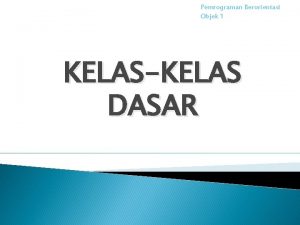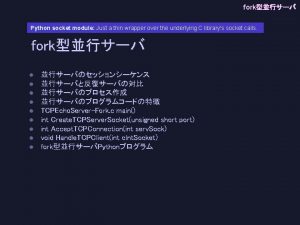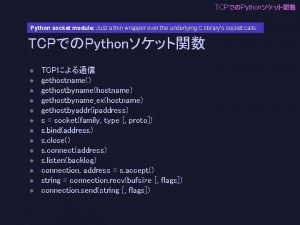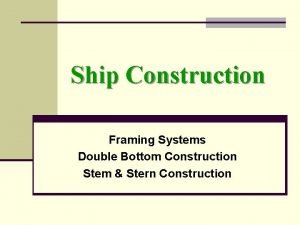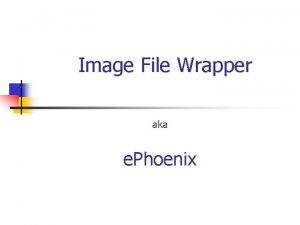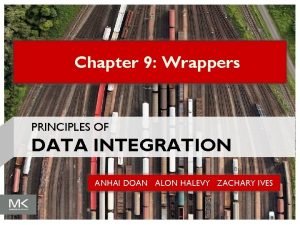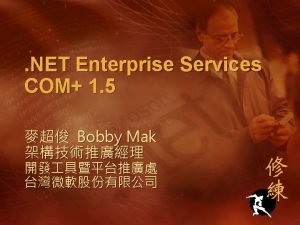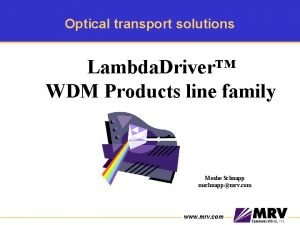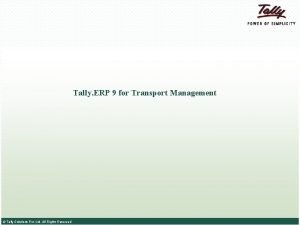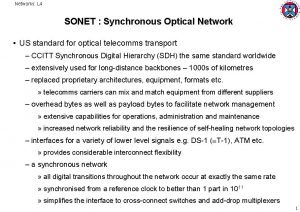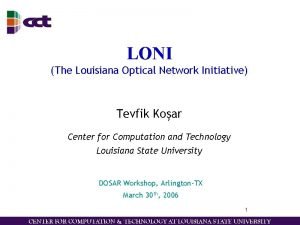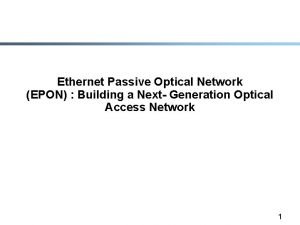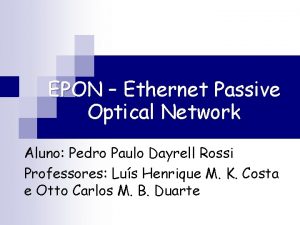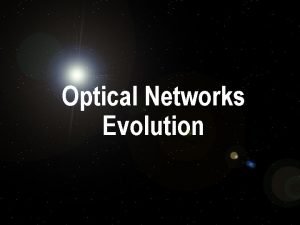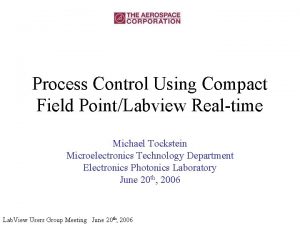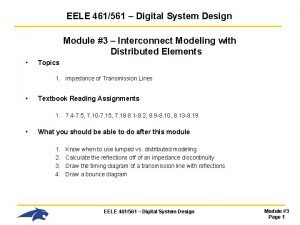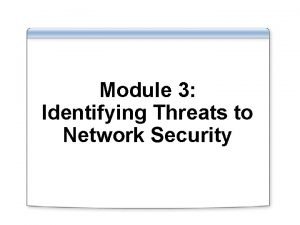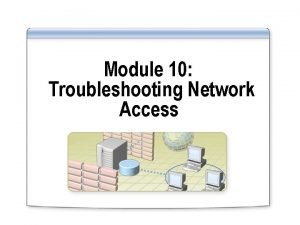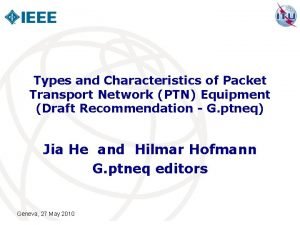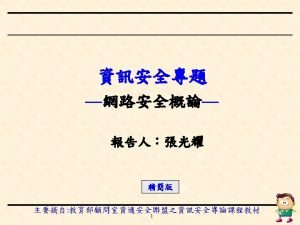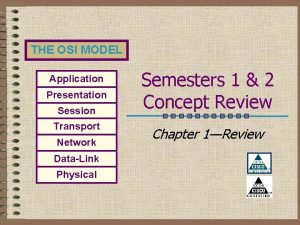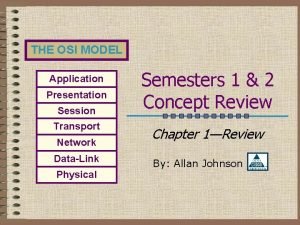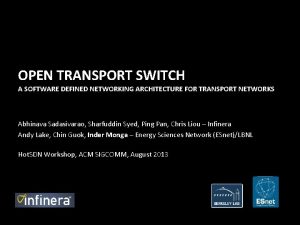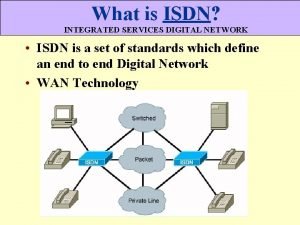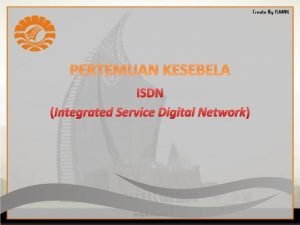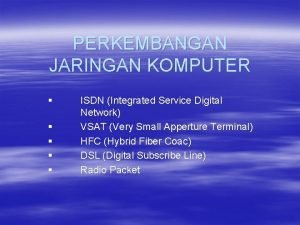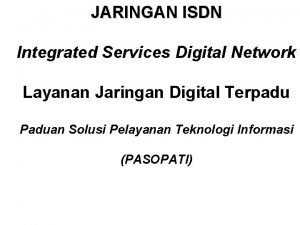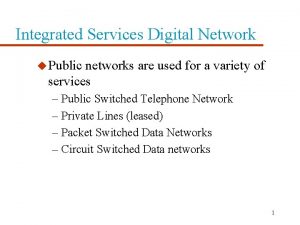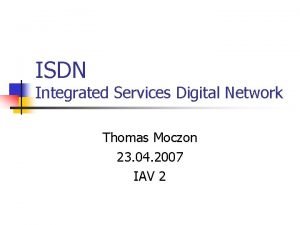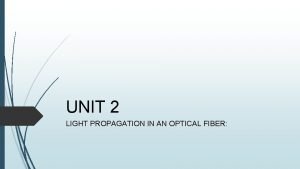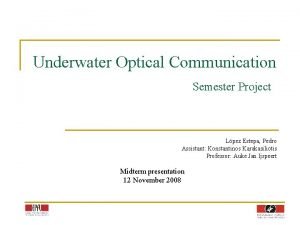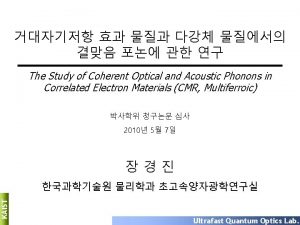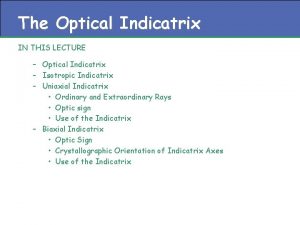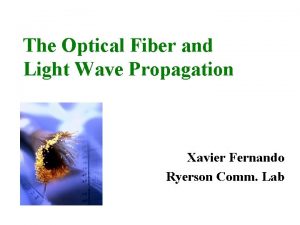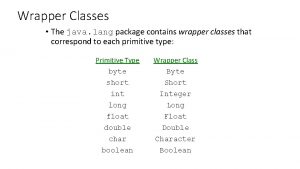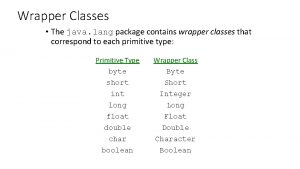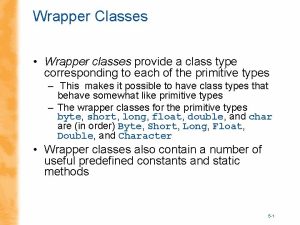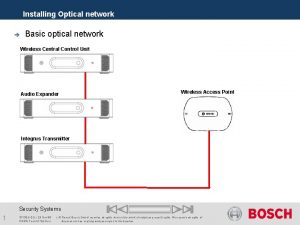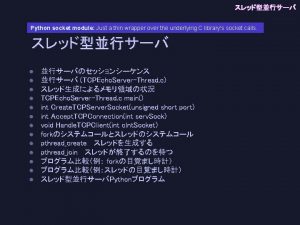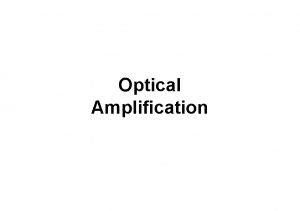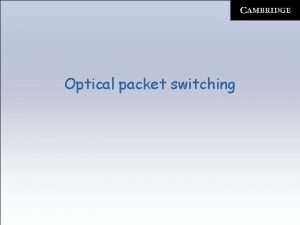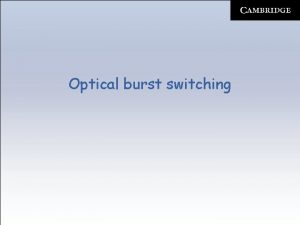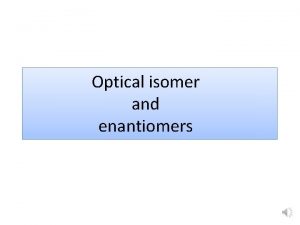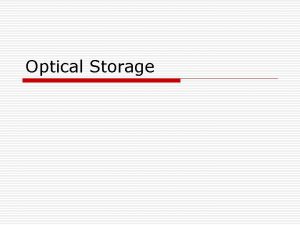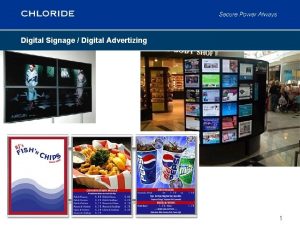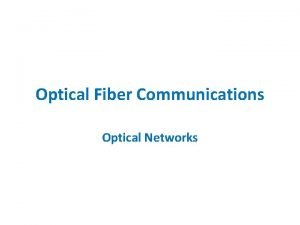Optical Transport Network Optical Transport Module Digital Wrapper


















![Multi-level Connection Monitoring: Applications Status working [protection] isbymonitored for ODUk switched circuit: UNI-UNI CM Multi-level Connection Monitoring: Applications Status working [protection] isbymonitored for ODUk switched circuit: UNI-UNI CM](https://slidetodoc.com/presentation_image_h2/6311aa628ecaeee16d63bd4845e4d1c5/image-19.jpg)



















![Generic-AIS [STM-AIS] n New maintenance signal @ STM-N level • a continuous repeating 2047 Generic-AIS [STM-AIS] n New maintenance signal @ STM-N level • a continuous repeating 2047](https://slidetodoc.com/presentation_image_h2/6311aa628ecaeee16d63bd4845e4d1c5/image-39.jpg)











![Mapping bit stream with[out] octet timing n G. 709 provides a generic mapping for Mapping bit stream with[out] octet timing n G. 709 provides a generic mapping for](https://slidetodoc.com/presentation_image_h2/6311aa628ecaeee16d63bd4845e4d1c5/image-51.jpg)























- Slides: 74

Optical Transport Network & Optical Transport Module "Digital Wrapper" Maarten Vissers Consulting Member of Technical Staff Lucent Technologies email: mvissers@lucent. com April 2002

Contents n OTN Rationale n OTN Layer Networks n Multi level Connection Monitoring n OTM Signals n Maintenance Signals n Mapping Client Signals n Multiplexing n Virtual Concatenation n OTN Standards April 2002 2

Contents n OTN Rationale n OTN Characteristics n OTN Layer Networks n Transitional Approaches n Multi level Connection Monitoring n Final Phase n O/E/O processing objectives n Digital processing objectives n OTM Signals n Maintenance Signals n Mapping Client Signals n Multiplexing n Virtual Concatenation n OTN Standards April 2002 3

OTN Characteristics n New transport networking layer (carrier grade solution) • Next step (after SDH/SONET) to support ever growing data driven needs for bandwidth and emergence of new broadband services – Terrabit/second per fiber via DWDM lines (transport level) – Gigabit/second paths at 2. 5 Gb/s, 10 Gb/s, 40 Gb/s (networking level) • Service transparency for SDH/SONET, ETHERNET, ATM, IP, MPLS – No change of SDH/SONET! – One exception; interpretation of STM-LOF alarm + STMAIS due to OTN fail • Enhanced OAM & networking functionality for all services • Shortest physical layer stack for data services (IP OTN Fiber) April 2002 4

OTN Characteristics n Gigabit level bandwidth granularity required to scale and manage multi-Terabit networks • Wavelength level switching maximizes nodal switching capacity, the gating factor for reconfigurable network capacity • Avoids very large numbers of fine granularity pipes that stress network planning, administration, survivability, and management April 2002 5

Transitional Approaches - Assessment n Extended SDH (attempt at creating a new layer using SDH elements) • Bandwidth multiplication by means of TDM more Gigabit/s on fiber (4 x) • Proprietary approaches attempting to carry lower rate STM-N [including all overhead] as a “service” within a higher rate STM-M (M>N) – strongly limited: SDH multiplexing hierarchy not designed to carry the STM-N (i. e. “itself”) as a service Ø No timing transparency Ø 90% of STM-N/OC-N overhead bytes not passed through Ø No STM-N/OC-N independent monitoring – Multiple proprietary implementations created in industry Ø no interworking April 2002 6

Transitional Approaches - Assessment n Pre-OTN WDM (simple transport - vs. networking - solution) • Bandwidth multiplication by means of WDM Terabit/s on fiber (100 x) • Client signal (e. g. STM-N, Gb. E) direct on wavelength – simple transport, no monitoring – or client specific non-intrusive monitoring Ø per client type a monitor is needed Ø additional client type implies additional monitor to be added – alarm suppression signal (e. g. AIS) specific per client type Ø additional client type implies additional alarm suppression signal to be added • Point-to-point application that can transport STM-N/OC-N as a service April 2002 7

Final Phase n OTN (networking solution) • Management enabler of WDM network by means of addition of: – Overhead to " " and "multi- " signals Ø "non-associated" or "out-of-channel" overhead; e. g. preventing alarm storms – Optical Channel (OCh) layer Ø STM-N, IP, ATM and Ethernet signals mapped ("wrapped") into OCh frame (OCh Data Unit (ODUk)) • First transmission technology in which each stakeholder gets its own (ODUk) connection monitoring • In addition ODUk supports/provides: – STM-N independent monitoring, becoming a service signal "itself", shortest physical layer stack for data services, TDM muxing, STMN inverse multiplexing, client independent protection switching, plesiochronous timing (no sync network required) April 2002 8

O/E/O Objectives n Minimise O/E/O processing in OTN • O/E/O processing at edges of administrative/vendor (sub)domains – Span engineering • O/E/O processing at edges of protected or switched domain – Span engineering (short/long route effects) – Signal Fail & Signal Degrade condition determination Ø If more than 1 optical transparent subnetwork is included • O/E/O processing at intermediate points – Span engineering (long line sections) – Losses in optical fabrics • O/E & E/O processing around electrical fabric April 2002 9

Digital Processing Objectives n Digital processing at locations where O/E/O is already performed • Fault and degradation detection • Service Level Agreement (SLA) verification • Signal Fail & Signal Degrade condition determination for protection and restoration (e. g. if high accuracy is required) April 2002 10

Contents n OTN Rationale n OTN Layer Networks n Multi level Connection Monitoring n Client Signals n Optical Channel Structure n OTM Signals n Containment Relationships n Maintenance Signals n n Mapping Client Signals Example of Layer Network Trails n Multiplexing n OTN Interfaces n Virtual Concatenation n n OTN Standards Standardised and "Proprietary" Stacks April 2002 11

OTN Layer Networks & Client Signals n Three new layer networks: IP/MPLS ATM ETHERNET STM-N • one "Gbit/s" path • • n 12 layer – OCh two section layers – OMSn – OTSn single channel section layer: – OPS 0 Client signals: • IP/MPLS • ATM • Ethernet • STM-N Optical Channel (OCh) layer network Interworking with pre-OTN STM-N Gb. E Optical Multiplex Section (OMSn) layer network OTM Physical Section (OPSn) Optical Transmission Section (OTSn) layer network OTM-0 OTM-nr, n>1 Optical Transport Module of order n (OTM-n, n 1) April 2002

Optical Channel Structure • 13 – OCh Data Unit (ODUk) – OCh Payload Unit (OPUk, k=1, 2, 3) – OCh Transport Unit (OTUk, OTUk. V) Analogue: OCh n Multiplexing (TDM) • ODUk multiplexing n ODUk virtual concatenation IP ATM ETHERNET STM-N Optical Channel Payload Unit (OPUk) Optical Channel Data Unit (ODUk) ODUk CF OPUm (m>k) ODUm (m>k) Optical Channel Transport Unit (OTUk, OTUk. V) STM-N Gb. E Optical Channel layer network consists of 3+1 structures: • Digital: TDM n Optical Channel (OCh) OCh CF CF: Connection Function April 2002

OTN Containment Relationships Non-associated overhead Associated overhead Wrapper Client OH OH OH OCh Payload Unit (OPUk) Client OCh Data Unit (ODUk) OPUk ODUk FEC Optical Channel (OCh) OTUk OH OCC OH OH OOS OSC OCC OMSn OPSn OTSn OCh Transport Unit (OTUk) Optical Channel Carrier (OCC) OCC OPS 0 Optical Multiplex Section Optical Transmission Section OTM Overhead Signal Optical Transport Module Optical Supervisory Channel Optical Physical Section April 2002 14

OTN Layer Network Trails n Example of OTSn, OMSn, OCh, OTUk, ODUk, OPS 0 trails • Transport of STM-N signal via OTM-0, OTM-n and STM-N lines STM-N ODUk OMSn OTSn 3 R LT OTM-n Client OTM-0 OPS 0 DXC 3 R OCh, OTUk OMSn OTSn OCADM R 3 R ODXC LT OSn 3 R STM-N OCh, OTUk DXC Client LT Line Terminal w/ optical channel multiplexing OCADM Optical Channel Add/Drop Multiplexer ODXC ODU Cross-Connect 3 R O/E/O w/ Reamplification, Reshaping & Retiming and monitoring R Repeater April 2002 15

OTN Interfaces n User to Network Interface (UNI) n Network Node Interface (NNI) • Inter Domain Interface (Ir. DI) • Intra Domain Interface (Ia. DI) Ø between equipment of different vendors (Ir. VI) Ø within subnetwork of one vendor (Ia. VI) Network Operator B USER A OTM UNI Network Operator C OTM NNI Ia. DI-Ir. VI OTM NNI Ia. DI-Ia. VI Vendor X OTM NNI Ia. DI-Ia. VI OTM NNI Ir. DI Vendor Y April 2002 16

Standardised & "Proprietary" stacks Proprietary elements: wavelengths • bit rates of wavelengths • supervisory channel n OPUk ODUk. T OTUk. V • FEC • frame format • ODUk mapping used between (and within) OTN transparent subnetworks used within OTN transparent subnetworks; implementations are very much technology dependent 17 ODUk. P OCh OTUk. V substructure OTM-n. m • optical parameters • number of OCh n Clients (e. g. STM-N, ATM, IP, Ethernet) OChr OMSn OPSn OTM-n. m Full functionality Reduced functionality OTM-0. m OTM-nr. m April 2002

Contents n OTN Rationale n OTN Layer Networks n Multi level Connection Monitoring n Application n OTM Signals n Nesting n Maintenance Signals n Overlapping n Mapping Client Signals n Multiplexing n Virtual Concatenation n OTN Standards April 2002 18
![Multilevel Connection Monitoring Applications Status working protection isbymonitored for ODUk switched circuit UNIUNI CM Multi-level Connection Monitoring: Applications Status working [protection] isbymonitored for ODUk switched circuit: UNI-UNI CM](https://slidetodoc.com/presentation_image_h2/6311aa628ecaeee16d63bd4845e4d1c5/image-19.jpg)
Multi-level Connection Monitoring: Applications Status working [protection] isbymonitored for ODUk switched circuit: UNI-UNI CM Qo. Sprovided of ofofclient provided signal by leased transport circuitisconnection is ismonitored by by. User Service Network Provider Operator to initiate "connection re-establishment" SF and SD switch conditions Path CM Verify Qo. S CM UNI-UNI CM NNI-NNI CM USR 2 NO A NO B Client Signal ODUk NO C Working W/P CM USR 1 ODUk Protection Client Signal April 2002 19

Multi-level Connection Monitoring: Nesting April 2002 20

Multi-level Connection Monitoring: Nesting and Overlapping April 2002 21

Contents n OTN Rationale n OTM Interface Signals • OTM-16 r. m • OTM-0. m • OTM-n. m n OTN Layer Networks n Multi level Connection Monitoring n OTM Signals versus OTN I/F n Maintenance Signals n OTM Overhead Signal n Mapping Client Signals n n Multiplexing Frame Formats • OTUk, ODUk n Virtual Concatenation n n OTN Standards Overhead • OTUk, ODUk n OTUk. V n Overhead versus OTN I/F April 2002 22

OTM-16 r. m Signal (m=1, 2, 3, 12, 23, 123) n Up to 16 wavelengths carrying traffic, with fixed 200 GHz grid independent of bit rate (2 G 5, 10 G, 40 G) n Optical parameters according to ITU-T Recommendation G. 959. 1 n Bit rate and format of the associated overhead according to ITU-T Recommendation G. 709 n No Optical Supervisory Channel (OSC) • non-associated overhead not required; i. e. 3 R points at each end, no repeaters 23 April 2002

OTM-0. m Signal (m=1, 2, 3) n Single channel signal ("colourless": 1310 or 1550 nm) n Optical parameters according to ITU-T Recommendation G. 959. 1 n Bit rate and format of the associated overhead according to ITUT Recommendation G. 709 n No Optical Supervisory Channel (OSC) • non-associated overhead not required; i. e. 3 R points at each end, no repeaters April 2002 24

OTM-n. m Signal (m=1, 2, 3, 12, 23, 123) 3 n Up to "n" wavelengths carrying traffic, with a grid dependent on bit rate n 1 "out-of-band" Optical Supervisory Channel (OSC) transporting the OTM Overhead Signal (OOS) n OTM Overhead Signal transports OTS, OMS, OCh (nonassociated) overhead and General management communications April 2002 25

OTM Signals versus OTN Interfaces April 2002 26

OTM Overhead Signal (OOS) «Non-associated overhead» n OOS functions subject to standardization n OOS bit rate & format not standardized OCh OH extensions may be expected in future to support e. g. OCh protection (e. g. OCh SPring) n FDI-P TTI 1 BDI-O FDI-O BDI-P FDI-P PMI OCh BDI-O OMSn OTSn Non-Associated overhead FDI-O 2 3 Vendor Specific OCI General Management Communications BDI: Backward Defect Indication FDI-O: Forward Defect Indication - Overhead FDI-P: Forward Defect Indication - Payload OCI: Open Connection Indication PMI: Payload Missing Indication TTI: Trail Trace Identifier April 2002 27

OTUk OH 2 3 ODUk OPUk OH Client Signal mapped in OPU k Payload OPUk Payload 4080 3825 3824 14 15 16 17 7 8 1 1 Alignm OTUk FEC 4 Client Signal OPUk - Optical Channel Payload Unit ODUk - Optical Channel Data Unit k indicates the order: 1 2. 5 G OTUk - Optical Channel Transport Unit 2 10 G 3 40 G Alignment April 2002 28 OTUk bit rate: 255/(239 -k) * "STM-N" ODUk bit rate: 239/(239 -k) * "STM-N" OTUk and ODUk frame formats (k=1, 2, 3)

OTUk and ODUk Overhead (k=1, 2, 3) GCC 1 ODUk GCC 2 TCM 6 TCM 2 TCMi GCC 0 TCM 5 OPU k Payload TCM 1 APS/PCC Activation/deactivation control channel 1 Automatic Protection Swiching 1 2 3 4 5 6 7 8 1 1 coordination channel 1 2 3 4 5 TTI 6 7 8 1 2 EXP: Experimental FAS: Frame Alignment TTI Signal FTFL: Fault Type & Fault Location reporting channel GCC: General Communication Channel PM ACT: APS: SM RES TCM 4 FTFL EXP PM RES Mapping & Concat Specific PSI MFAS: Multi. Frame Alignment Signal 2 3 PCC: Protection Communication Control channel 2 3 4 5 6 7 8 1 2 3 4 5 0 6 7 PT 8 2 PM: Path Monitoring 3 1 3 4 PSI: 5 BIP-8 6 Payload 7 8 1 Structure 2 3 BEI 4 Identifier 5 6 7 STAT 8 Mapping RES: Reserved. BEI/BIAE for future international BIP-8 STAT& Concat standardisation 255 Specific SM: Section Monitoring TCM: Tandem Connection Monitoring BDI TCM 3 MFAS BDI OTUk Alignm. FAS OH TCM RES ACT OPUk OH «Associated overhead» April 2002 29

OTUk. V (k=1, 2, 3) n Frame format is vendor specific n Forward Error Correction code is vendor specific n Minimum overhead set to support is: • Trail Trace Identifier • Error Detection Code (e. g. BIP) • Backward Defect Indicator • Backward Error Indicator • (Backward) Incoming Alignment Error n Other overhead is vendor specific n ODUk mapping into OTUk. V is vendor specific April 2002 30

Overhead versus OTN Interfaces n OTM Interface Ports on IP Router, ATM Switch, Ethernet Switch and SDH equipment should support the following minimum set of overhead • OPUk Client Specific • OPUk Payload Structure Identifier (PSI) • ODUk Path Monitoring (PM) • OTUk Section Monitoring (SM) • Frame Alignment (FAS, MFAS) April 2002 31

Overhead versus OTN Interfaces n Overhead passed through network • OTM UNI to OTM UNI • OTM NNI Ir. DI to OTM NNI Ir. DI April 2002 32

Overhead versus OTN Interfaces n Overhead passed through network from OTM UNI to OTM UNI interface • OPUk PSI, Client Specific • ODUk PM, TCM ACT, TCM 1. . TCMn, TCM ACT, RES • ODUk GCC 1, GCC 2 according contract • ODUk APS/PCC definition is under study April 2002 33

Overhead versus OTN Interfaces n Overhead passed through network from OTM NNI Ir. DI to OTM NNI Ir. DI interface • OPUk PSI, Client Specific • ODUk PM, TCM ACT, TCM 1. . TCMm, TCM ACT, FTFL, RES – "m" in TCMm > "n" in TCMn (UNI-UNI) • ODUk GCC 1, GCC 2 according contract • ODUk APS/PCC definition is under study April 2002 34

Contents n OTN Rationale n OTN Layer Networks n Multi level Connection Monitoring n OTM Signals n Maintenance Signals n Mapping Client Signals n Multiplexing n Virtual Concatenation n OTN Standards n Forward Defect Indication (FDI, AIS) n Backward Defect & Error Indication (BDI, BEI) n Open Connection Indication (OCI) n Locked (LCK) n Fault Type & Fault Location (FTFL) April 2002 35

OTN Maintenance Signals: Alarm Suppression R use of OTN maintenance signals FDI, AIS and PMI will reduce number of alarms from 500 k to 1 per broken fiber R R OMS-FDI U D OTS-PMI k. A 3 R 1000 /fiber x 96 fibers/cable OCh-FDI x 5 cables/duct = 500 k lost signals ==> 500 k LOS alarms in network 36 OCh-FDI O R OCh-FDI at line termination point OMS-FDI is converted into OCH-FDI at 3 R point OCh-FDI is converted into ODUk-AIS IS use of OTN maintenance signal OTS-PMI (and OMS-PMI) will prevent OTS [OMS] LOS alarm when none of s is present. OCh-FDI R April 2002

OTN Maintenance Signals: Alarm Suppression (FDI, AIS) n AIS/FDI at • clients n AIS at • ODUk n AIS at • OTUk n FDI at • OCh n FDI/PMI at • OMSn n PMI at • OTSn April 2002 37

OTN Maintenance Signals: Alarm Suppression (FDI, AIS) n Generated at egress of OMSn, OCh and ODUk Link Connections n Inserted on detection of Signal Fail n OMSn-FDI and OCh-FDI • is non-associated overhead n ODUk-AIS • is special ODUk signal pattern (0 x. FF) April 2002 38
![GenericAIS STMAIS n New maintenance signal STMN level a continuous repeating 2047 Generic-AIS [STM-AIS] n New maintenance signal @ STM-N level • a continuous repeating 2047](https://slidetodoc.com/presentation_image_h2/6311aa628ecaeee16d63bd4845e4d1c5/image-39.jpg)
Generic-AIS [STM-AIS] n New maintenance signal @ STM-N level • a continuous repeating 2047 -bit PN-11 (1 + x 9 + x 11) sequence n Generated in OTN tributary ports • ingress trib: on detection of STM-N LOS • egress trib: on detection of ODUk signal fail type defect n To be detected in SDH line/trib ports in addition to STM-LOF as "STM-AIS" • In existing equipment detected as STM-LOF insertion detection April 2002 39

OTN Maintenance Signals: Backward Information (BDI, BEI) n RDI/REI at • Clients n BDI/BEI at • ODUk • OTUk n No BI at • OCh n BDI at • OTSn • OMSn April 2002 40

OTN Maintenance Signals: Open Connection Indication (OCI) n Generated in a Fabric n Inserted when output port is not connected to input port n OCh-OCI • is non-associated overhead n ODUk-OCI • special ODUk signal pattern (0 x 66) April 2002 41

OTN Maintenance Signals: Locked (LCK) n Generated in ODUk Tandem Connection endpoint n Inserted when Administrative State is Locked • to block a user to access the connection • to prevent test patterns within the network entering a user domain n ODUk-LCK • special ODUk signal pattern (0 x 55) April 2002 42

Fault Type & Fault Location (FTFL) n Helps Service Provider to automatically locate fault/degradation to specific Network Operator domain n No need to call around any longer n Section and Tandem Connection endpoints insert FTFL in forward direction on detection of SF or SD condition n Specific FTFL function at UNI • extracts forward info and sends it in opposite direction as backward info • filters outgoing and incoming FTFL information (security issue) n Specific FTFL extraction function • reads FTFL forward and backward information at intermediate point along connection April 2002 43

Contents n OTN Rationale n OTN Layer Networks n Multi level Connection Monitoring n OTM Signals n Maintenance Signals n CBR (e. g. STM-N) n Mapping Client Signals n IP, ETHERNET n ATM n Test Signals n Bit stream with/without octet timing n Bit Rate Agnostic CBR n n n Multiplexing Virtual Concatenation OTN Standards April 2002 44

n G. 709 defines interworking between both mappings • common demapper, and • bit synchronous mapping has fixed Justification Control (JC) STM-64 G. 709 provides two mappings for STM-N signals • bit synchronous • asynchronous STM-256 n STM-16 Mapping STM-N (N=16, 64, 256) D: Data, FS: Fixed Stuff, JC: Justification Control, N/PJO: Negative/Positive Justification. April Opportunity 2002 45

Mapping IP and Ethernet n G. 709 provides an encapsulation for packet based client signals n There is no need for SDH or 10 G-Ethernet to encapsulate IP n A new protocol is being defined: Generic Framing Procedure • a generic mechanism to carry any packet signal over fixed rate channels (e. g. SDH, SONET and OTN's ODUk) - ITU-T Rec. G. gfp Bandwidth for GFP stream in ODU 1: 2 488 320 kbit/s ODU 2: 9 995 276 kbit/s ODU 3: 40 150 519 kbit/s April 2002 46

Generic Framing Procedure G. 7041 April 2002 47

Mapping ATM n G. 709 provides a mapping for cell based client signals n Mapping ATM into ODUk is similar to mapping into SDH Bandwidth for ATM stream in ODU 1: 2 488 320 kbit/s ODU 2: 9 995 276 kbit/s ODU 3: 40 150 519 kbit/s April 2002 48

Mapping Test Signals n G. 709 provides a mapping for test signals n Two test signals are defined • NULL sequence (all-0's) April 2002 49

Mapping Test Signals n Two test signals are defined (continued) • 2 147 483 647 -bit Pseudo Random Binary Sequence (PRBS) 1 + x 28 + x 31 – groups of 8 successive PRBS bits are mapped into a data byte April 2002 50
![Mapping bit stream without octet timing n G 709 provides a generic mapping for Mapping bit stream with[out] octet timing n G. 709 provides a generic mapping for](https://slidetodoc.com/presentation_image_h2/6311aa628ecaeee16d63bd4845e4d1c5/image-51.jpg)
Mapping bit stream with[out] octet timing n G. 709 provides a generic mapping for client signals encapsulated into a bit stream, with or without octet timing n A regional standards organisation or an industry forum may deploy this mapping for a new client signal n It must also define the OPUk Client Specific (CS) overhead April 2002 51

Bit Rate Agnostic CBR Mapping n New mapping method which maps a CBR signal of any rate (within a range up to OPUk payload capacity) n Bit rate is a fixed bit rate with a small tolerance in the ppm range. n For inclusion in G. 709 version 2 n Description in G. 709 Living List n Further development in 2001/2002 timeframe April 2002 52

Contents n OTN Rationale n OTN Layer Networks n Multi level Connection Monitoring n OTM Signals n Maintenance Signals n Mapping Client Signals n Multiplexing n Virtual Concatenation n OTN Standards n Wavelength Division Multiplex (WDM) n Time Division Multiplex (TDM) n TDM Tributary Slots n TDM Overhead n TDM Mapping April 2002 53

Wavelength Division Multiplex n OTM-16 r. m signal • 16 channels • fixed 200 GHz grid independent of bit rate of OCh signal • designed for interworking purposes n OTM-n. m signal • no predefined number of channels • no predefined grid • grid may depend on bit rate of OCh signal – e. g. 25, 50, 100 GHz for OTU 1, OTU 2, OTU 3 resp. • developments in technology are driving capabilities April 2002 54

Wavelength Division Multiplex - Structure April 2002 55

Time Division Multiplex n TDM muxing in the OTN will be applied for: • lower rate service signal transport – in long distance line systems and/or sub-networks optimised for single (higher) bit rate • increased throughput – in optical fabrics and/or sub-networks • reduced administrative complexity – in large networks • lower cost networks n TDM muxing introduces additional complexity when tributary signal must be routed • requires demux and mux stages around switch fabric April 2002 56

Time Division Multiplex n TDM muxing is muxing of ODUk signals into higher order ODUk signals • ODU 1 into ODU 2 • ODU 1 and/or ODU 2 into ODU 3 – ODU 1 into ODU 2 into ODU 3 is possible, but not the recommended method when ODU 1 s are the service signals that are to be switched/cross connected within an "ODU 3 network" – if ODU 1 s enter such ODU 3 network via ODU 2, the ODU 2 is terminated at the edge and the ODU 1 s are remultiplexed into an ODU 3 – if ODU 2 is service signal, of course no demuxing/remuxing will occur at edges n Multiplexing via byte interleaving April 2002 57

Time Division Multiplex - Structure April 2002 58

Time Division Multiplex - artist impression n 4 x ODU 1 into ODU 2 payload • ODU 1 adapted to ODU 2 clock via justification • adapted ODU 1 signals byte interleaved into OPU 2 • ODU 2 and OTU 2 overhead added n ODU 1 floats in ¼ of the OPU 2 n ODU 1 frame will cross an ODU 2 frame boundary April 2002 59

Time Division Multiplex ODU 2 Tributary Slot Allocation April 2002 60

Time Division Multiplex ODU 3 Tributary Slot Allocation April 2002 61

Time Division Multiplex - Overhead MSI, JC, PJO 1, PJO 2 April 2002 62

Time Division Multiplex - Mapping n Asynchronous mapping of ODU information bytes n -1, 0, +1, +2 byte justification control n ODU 1 into ODU 3 mapping includes Fixed Stuff column • ODU 1 into ODU 2 and ODU 2 into ODU 3 mapping is without fixed stuff April 2002 63

Contents n OTN Rationale n OTN Layer Networks n Multi level Connection Monitoring n OTM Signals n Maintenance Signals n Mapping Client Signals n Multiplexing n ODUk-Xv Virtual Concatenation n OPUk-Xv Overhead n Mapping Client signals n n OTN Standards April 2002 64

Virtual Concatenation n Virtual Concatenated ODUk's • ODUk-Xv, with X=1. . 256 n Provide • Ability to transport STM-64 and STM-256 signals via fibers not supporting 10 G and/or 40 G wavelengths – STM-64 into ODU 1 -4 v – STM-256 into ODU 2 -4 v or ODU 1 -16 v • Finer granularity bandwidth for data signals – X * 2 G 5 [10 G] [40 G] via ODU 1 -Xv [ODU 2 -Xv] [ODU 3 -Xv] – Application of Link Capacity Adjustment Scheme (LCAS, Rec. G. 7042) offers Ø Hitless bandwidth modification Ø Build in resilience when signal components routed via two or more diverse routes April 2002 65

Virtual Concatenation - Inverse muxing n Mapping of client signal into OPUk-X n Inverse muxing of OPUk-X signal into X OPUk signals n ODUk overhead is added to each of the X OPUk signals n ODUk signals are transported April 2002 66

Virtual Concatenation - Overhead n PSI • vc. PT n VCOH • MFI 1, MFI 2 • SQ • LCAS – – – CTRL GID RSA MST CRC 8 Res April 2002 67

Virtual Concatenation - Mapping n STM-N • asynchronous • bitsynchronous n ATM n GFP (IP, ETH, MPLS) n STM-64 into OPU 1 -4 v STM-256 into OPU 2 -4 v Test signals STM-256 into OPU 1 -16 v April 2002 68

Contents n OTN Rationale n OTN Layer Networks n Multi level Connection Monitoring n OTM Signals n Maintenance Signals n Mapping Client Signals n Multiplexing n Virtual Concatenation n OTN Standards April 2002 69

OTN Standards in ITU-T - Transport Plane 70 n Framework G. 871 (10/00) n Network Architecture G. 872 (10/01) n Structures and bit rates G. 709 (02/01), G. 709 am. 1 (10/01) n Equipment G. 798 (10/01) n Equipment Management Function G. 874 (10/01), G. 7710 (11/01) n Protection G. gps (2002), G. otnprot (2002) n Data Communication Network G. 7712 (10/01) n Jitter & Wander Performance G. 8251 (2002) n Error Performance G. optperf (2002) n Physical G. 959. 1 (02/01), G. 693, G. dsn (2003) n Information Model G. 874. 1 (10/01), G. 875 (2002) n Optical Safety G. 664 (06/99) n Generic Framing Procedure G. 7041 (10/01) n Link Capacity Adjustment Scheme G. 7042 (10/01) n Bringing into Service & Maintenance M. 24 otn (2003) n Q factor measurement O. qfm (? ) April 2002

OTN Standards in ITU-T - Control Plane n Automatic Switched Transport Network G. 807 (05/01) n Automatic Switched Optical Network G. 8080 (10/01) n Distributed Connection Management G. 7713 (10/01) n Automatic Discovery Techniques G. 7714 (10/01) n Routing G. 7715 (2002) n Signalling Communication Network G. 7712 (10/01) n Link Resource Manager G. 7716 (2002? ) April 2002 71

OTN Standards in ITU-T April 2002 72

OTN Standards in ITU-T April 2002 73

THANK YOU
 Optical transport module
Optical transport module Tipe data wrapper
Tipe data wrapper Vray mtl
Vray mtl Fork socket
Fork socket C printf wrapper
C printf wrapper Python gethostbyaddr
Python gethostbyaddr Transverse frame ship
Transverse frame ship Akaephoenix
Akaephoenix Hlrt wrapper
Hlrt wrapper Primitive computer science
Primitive computer science Vray
Vray Wrapper induction in web mining
Wrapper induction in web mining System.enterpriseservices.wrapper.dll
System.enterpriseservices.wrapper.dll Gradle android app development
Gradle android app development C device module module 1
C device module module 1 Lambda driver
Lambda driver Tally transport module
Tally transport module Pdh
Pdh Sonet synchronous optical network
Sonet synchronous optical network Loni pop
Loni pop Gigabit ethernet passive optical network
Gigabit ethernet passive optical network Gigabit ethernet passive optical network
Gigabit ethernet passive optical network Optical network evolution
Optical network evolution Optical mesh network
Optical mesh network Relay output module for compact fieldpoint
Relay output module for compact fieldpoint Digital design module 3
Digital design module 3 Module 3: information and network security
Module 3: information and network security Troubleshooting
Troubleshooting Symport
Symport Active transport
Active transport Passive transport vs active transport venn diagram
Passive transport vs active transport venn diagram Active vs passive transport venn diagram
Active vs passive transport venn diagram Pinocytosis vs phagocytosis
Pinocytosis vs phagocytosis Primary active transport vs secondary active transport
Primary active transport vs secondary active transport Bioflix activity membrane transport active transport
Bioflix activity membrane transport active transport Passive trnasport
Passive trnasport Bioflix activity membrane transport active transport
Bioflix activity membrane transport active transport Ptn packet transport network
Ptn packet transport network Osi model
Osi model Application transport network link physical
Application transport network link physical Number of bits borrowed
Number of bits borrowed Application presentation session transport network
Application presentation session transport network Open transport network
Open transport network Apa pengertian dari warga digital
Apa pengertian dari warga digital E-commerce: digital markets, digital goods
E-commerce: digital markets, digital goods Digital data digital signals
Digital data digital signals Digital data transmission
Digital data transmission E-commerce: digital markets, digital goods
E-commerce: digital markets, digital goods Digital encoding schemes
Digital encoding schemes Luxembourg digital innovation hub
Luxembourg digital innovation hub E-commerce digital markets digital goods
E-commerce digital markets digital goods Integrated digital services network switch
Integrated digital services network switch Episcopal digital network
Episcopal digital network Isdn architecture
Isdn architecture Isdn komputer adalah
Isdn komputer adalah Isdn bra
Isdn bra Integrated digital services network
Integrated digital services network Digital signature in cryptography and network security
Digital signature in cryptography and network security Ntba wiki
Ntba wiki A switch in a datagram network uses a
A switch in a datagram network uses a Network topologies
Network topologies Features of peer to peer network and client server network
Features of peer to peer network and client server network Network systems design using network processors
Network systems design using network processors Network centric computing
Network centric computing Circuit switching disadvantages
Circuit switching disadvantages Conclusion of optical illusion
Conclusion of optical illusion A ray of light travels from an optical denser
A ray of light travels from an optical denser Numerical aperture of optical fiber
Numerical aperture of optical fiber Underwater optical control
Underwater optical control Optical vs acoustic phonons
Optical vs acoustic phonons Polarization of light
Polarization of light Isotropic indicatrix
Isotropic indicatrix Skew rays in optical fiber
Skew rays in optical fiber Amino acid optical isomers
Amino acid optical isomers Precision optical lab
Precision optical lab

